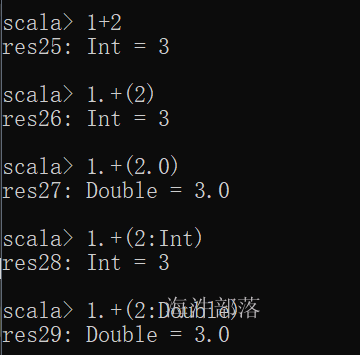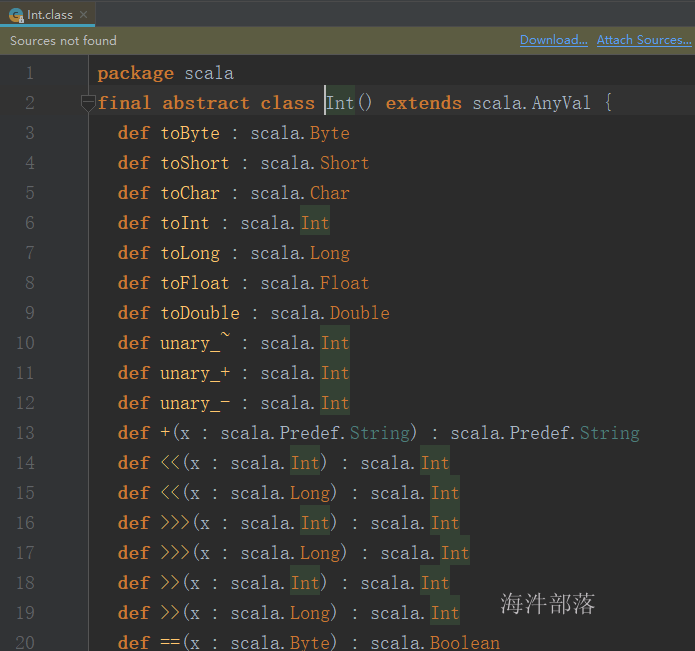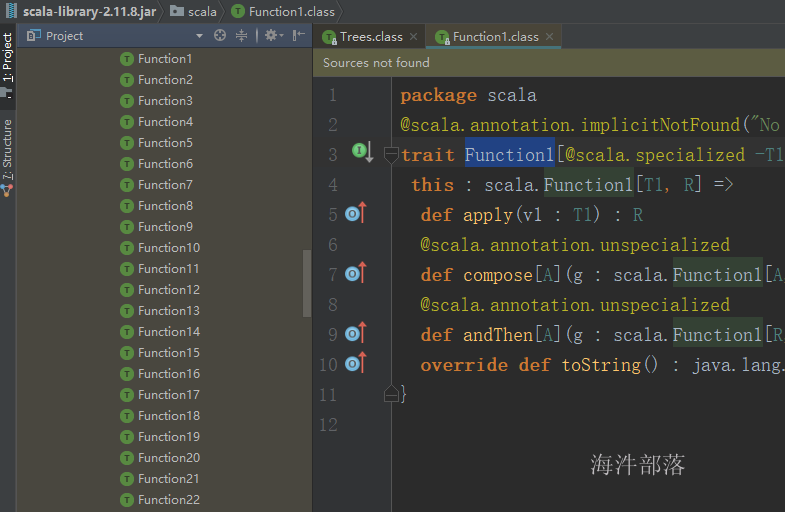5 方法与函数
5.1 方法
在scala中的操作符都被当成方法存在,比如说+、-、*、/
1+2就是1.+(2)的调用,
2.0 是doule类型,强调用Int类型的写法为1.+(2:Int)

可以在idea中搜索Int类查看支持的方法

方法声明与使用
定义方法的语法:
def 方法名([变量:变量类型,变量:变量类型]):返回值类型={方法体}其中:
在scala 中,方法里面的最后一个表达式的值就是方法的返回值,不需要return 返回;
示例:
定义无参无返回值的方法:
// 定义无参无返回值的方法
scala> def say():Unit = {println("say hello")}
say: ()Unit
scala> say()
say hello
// 简化过程
scala> def say():Unit = {println("say hello")}
say: ()Unit
// 方法体有一个语句,省略{}
scala> def say():Unit = println("say hello")
say: ()Unit
// 方法返回值可以由方法体返回结果类型推测
scala> def say() = println("say hello")
say: ()Unit
// 方法形参列表是空, 可省略()
scala> def say = println("say hello")
say: Unit
scala> say
say hello
scala> say()
<console>:13: error: Unit does not take parameters
say()
// 带有返回值的方法
def add(a:Int, b:Int):Int={val c = a + b; return c}定义带有有参有返回值方法:
// 定义带有有参有返回值方法
scala> def add(a:Int, b:Int):Int={val c = a + b; return c}
add: (a: Int, b: Int)Int
scala> add(4,5)
res8: Int = 9
// 简化流程
scala> def add(a:Int, b:Int):Int={val c = a + b; return c}
add: (a: Int, b: Int)Int
// scala 不建议用return返回方法结果,默认最后一个就是方法的返回值
scala> def add(a:Int, b:Int):Int={val c = a + b; c}
add: (a: Int, b: Int)Int
// 去掉中间变量c
scala> def add(a:Int, b:Int):Int={a + b}
add: (a: Int, b: Int)Int
// 方法体有一个语句,省略{}
scala> def add(a:Int, b:Int):Int=a + b
add: (a: Int, b: Int)Int
// 方法返回值可以由方法体返回结果类型推测
scala> def add(a:Int, b:Int)=a + b
add: (a: Int, b: Int)Int
scala> add(4,5)
res9: Int = 9方法的调用:
object M1 {
def say(name:String) = {
println(s"say ${name}")
}
def add(a:Int, b:Int) = a + b
def main(args: Array[String]): Unit = {
// 普通调用
M1.say("hainiu")
// 中缀方法调用
M1 say "hainiu"
// 大括号调用,当只有一个入参时才能用
M1 say {"hainiu"}
M1.add(4,5)
// 中缀方法调用
M1 add (4,5)
}
}5.2 函数
在 java 中方法和函数是一个意思,在 scala 中方法和函数是两种含义。
在 scala 中,函数是一等公民。可以在任何地方定义,在函数内或函数外,可以作为函数的参数和返回值;函数还可以赋给变量。
函数声明:
val 变量名:[变量类型1,变量类型2 => 函数体返回类型 ] = ([变量:变量类型,变量:变量类型]) => 函数体示例:
// 函数本身是没有名字的--匿名函数
// function2 是 函数有 两个输入参数 和 一个输出, 本例是 两个Int输入,一个Int输出
scala> (a:Int, b:Int) => a + b
res10: (Int, Int) => Int = <function2>
scala> res10(4,5)
res11: Int = 9
// 把匿名函数赋给变量,这个变量名称就成了函数名称
scala> val add:(Int,Int)=>Int = (a:Int, b:Int) => a + b
add: (Int, Int) => Int = <function2>
scala> add(4,5)
res12: Int = 9function中的参数最多有22个

函数的结果做为方法的参数:
示例:
// 定义周长函数
val perimeter = (a:Int,b:Int) => (a+b) *2
// 定义面积函数
val area = (a:Int, b:Int) => a*b
// 定义求和方法
def add(a:Int, b:Int) = a+b
// 计算长方形周长和面积的和
println(add(perimeter(4,5), area(4,5)))函数作为方法的参数:
// 定义js方法,内部有个入参是函数
scala> def js(a:Int, b:Int, func:(Int,Int)=>Int) = func(a,b)
js: (a: Int, b: Int, func: (Int, Int) => Int)Int
// 调用时,只要符合两个Int输入,一个Int输出的函数都可以作为参数
scala> js(4,5, perimeter) // 计算周长
res13: Int = 18
scala> js(4,5, area) // 计算面积
res14: Int = 20方法转换成函数
1)用空格下划线的方式
# 定义方法
def add_def(a:Int,b:Int) = a + b
# 方法转函数,用空格下划线的方式
val add_func = add_def<空格>_2)也可以把方法当参数使用,这也因为scala会隐式的把方法转换成函数,但并不是直接支持方法当参数的模式,只是做了隐式的转换,这种函数的转换分两种显示用<空格>_和隐式的,这也体现了scala灵活的地方。
# 定义方法add_def
def add_def(a:Int,b:Int) = a + b
# 定义方法js,接收参数是函数
def js(a:Int, b:Int, func:(Int,Int) => Int) = func(a,b)
# 隐式的将方法转换成了函数
println(js(add_def))
